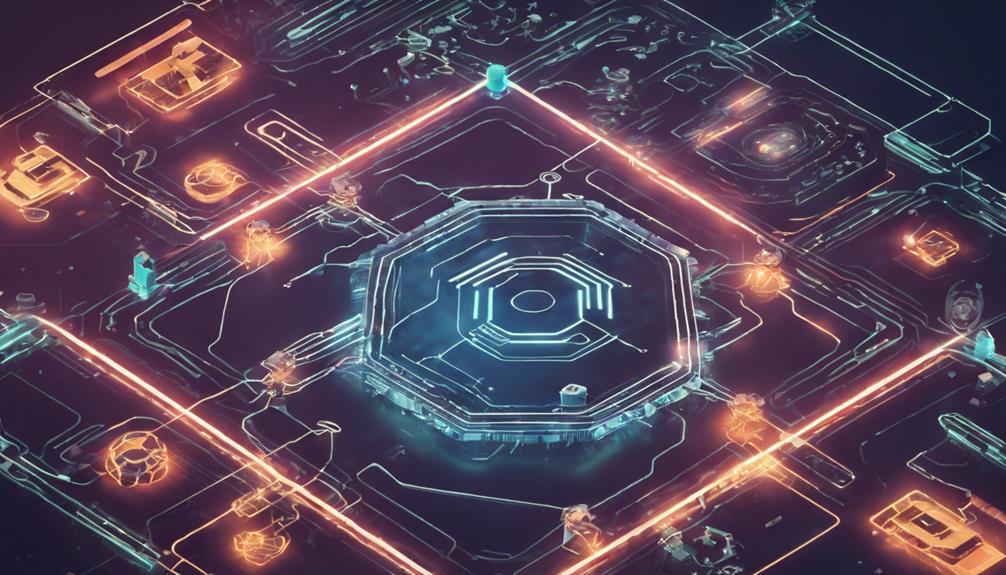Generative AI security is at the forefront of cyber defense, offering proactive threat detection and adaptive defense mechanisms. It revolutionizes cybersecurity by staying ahead of evolving threats through real-time monitoring and response to anomalies. Utilizing AI for threat identification and continuous learning enhances defense capabilities against sophisticated attacks. By simulating attack scenarios and bolstering defense mechanisms, organizations can prepare and mitigate security risks effectively. This cutting-edge technology empowers defenses to adapt swiftly to new attack vectors while safeguarding sensitive data. Embracing generative AI is essential for enhancing cybersecurity measures in the ever-changing landscape of digital threats.
Key Takeaways
- Leveraging generative AI for proactive threat detection.
- Enhancing defense mechanisms with adaptive learning.
- Real-time monitoring for evolving cyber threats.
- Strengthening security posture against sophisticated attacks.
- Continuous training for dynamic cyber defense strategies.
The Rise of Generative AI Security
The emergence of generative AI security marks a pivotal advancement in the domain of cybersecurity defense against increasingly sophisticated threats. Generative AI, the next frontier in cyber defense, represents a proactive approach to combat the risks posed by malicious utilization of AI technology. By leveraging generative AI, security measures can now detect and mitigate the vulnerabilities associated with AI-driven attacks, providing an essential layer of protection for digital systems.
With cyber criminals evolving their tactics and utilizing generative AI to launch sophisticated assaults, the rise of generative AI security is imperative in ensuring robust defense mechanisms in the digital landscape.
Through the implementation of generative AI security, organizations can fortify their systems and networks against emerging threats, staying one step ahead of malicious actors. This focus on safeguarding systems from AI-powered attacks underscores the critical need for advanced defense strategies to uphold cybersecurity standards in an ever-changing technological environment.
Detecting Evolving Cyber Threats

As cyber threats continue to evolve, the need for dynamic threat recognition and adaptive defense mechanisms becomes paramount in safeguarding digital assets.
By staying ahead of malicious actors through proactive measures, organizations can enhance their cybersecurity posture and mitigate potential risks effectively.
Leveraging advanced technologies such as artificial intelligence and logical reasoning can greatly bolster threat detection capabilities and empower security teams to respond swiftly to emerging cyber threats.
Dynamic Threat Recognition
Harnessing advanced AI algorithms, Dynamic Threat Recognition is pivotal in real-time detection of evolving cyber threats. By continuously analyzing network behavior, AI-powered systems can swiftly identify anomalies that may indicate potential security breaches. This proactive approach allows machine learning models within Dynamic Threat Recognition to adapt and evolve, enabling the detection of new and sophisticated cyber attacks.
Through real-time monitoring and analysis of network traffic patterns, organizations can enhance their cybersecurity measures by responding promptly to emerging threats.
The ability to detect and mitigate risks before they materialize into significant damage is a key benefit of Dynamic Threat Recognition. This technology empowers businesses to stay ahead of evolving cyber threats, safeguarding their valuable data and systems effectively.
Adaptive Defense Mechanisms
Detecting Evolving Cyber Threats, adaptive defense mechanisms utilize generative AI to analyze data patterns and anomalies, enabling proactive identification of potential security breaches in real-time.
By harnessing the power of generative AI, these mechanisms can continuously learn and adapt, staying one step ahead of sophisticated cyber attacks. This cutting-edge technology enhances threat detection capabilities by pinpointing even the subtlest changes in network behavior that may signify a security threat.
Organizations leveraging generative AI in their adaptive defense strategies are bolstering their cybersecurity posture against the ever-evolving landscape of digital threats. The essential nature of these mechanisms provides a critical advantage in combating emerging cyber risks, ensuring that security teams can respond swiftly and effectively to potential breaches.
In a world where cyber threats are constantly evolving, adaptive defense mechanisms powered by generative AI offer a proactive and dynamic approach to safeguarding sensitive data and systems.
Proactive Defense Mechanisms

Utilizing advanced AI technologies, proactive defense mechanisms in generative AI security are designed to anticipate and counter potential cyber threats before they materialize. These mechanisms leverage generative AI models like Large Language Models (LLMs) to analyze patterns, detect anomalies, and enhance incident response times. By implementing proactive measures, organizations can effectively stay ahead of evolving cyber threats, safeguarding their systems and data.
| Key Components of Proactive Defense Mechanisms |
|---|
| Continuous Monitoring |
| Threat Intelligence Integration |
| Adaptive Security Controls |
Continuous monitoring guarantees real-time visibility into network activities, while integrating threat intelligence enhances the system's capability to identify and respond to emerging threats swiftly. Adaptive security controls allow for dynamic adjustments based on the evolving threat landscape, creating a robust defense mechanism against potential cyberattacks. Proactive defense in generative AI security serves as an essential strategy in preventing breaches, unauthorized access, and data manipulation, offering organizations a proactive approach towards cybersecurity.
Simulating Attack Scenarios

To enhance cybersecurity preparedness, organizations employ generative AI to simulate attack scenarios, allowing for proactive identification and mitigation of potential vulnerabilities.
Simulating attack scenarios with generative AI provides a realistic testing environment where cybersecurity teams can evaluate their defense mechanisms against evolving threats. These simulations offer valuable insights into potential weak points in the system that malicious actors could exploit. By mimicking real-world attack scenarios, organizations can better prepare for and mitigate security risks effectively.
Identification of Vulnerabilities: Generative AI simulations help in pinpointing vulnerabilities that may go unnoticed in traditional security assessments.
Effectiveness Testing: Simulating attack scenarios enables organizations to assess the effectiveness of their current defense mechanisms and identify areas that require improvement.
Preparation and Risk Mitigation: By running these simulations regularly, organizations can proactively prepare for potential threats and take necessary steps to mitigate security risks before they escalate.
Staying Ahead of Malicious Actors

Effective defense against malicious actors leveraging AI for cyber attacks requires a proactive approach that incorporates advanced generative AI security measures. As cyber threats continue to evolve, staying ahead of malicious actors is paramount.
Understanding the sophistication of generative AI is essential in developing robust defense strategies against AI-driven cyber attacks. Proactive monitoring and detection mechanisms play an important role in mitigating the risks posed by AI-generated threats. By collaborating closely with cybersecurity experts, AI developers can tailor solutions that address the ever-changing landscape of cyber threats.
To effectively combat cyber attacks, organizations must implement AI-driven solutions that enhance response times and bolster overall security postures. By leveraging the power of generative AI in cybersecurity, businesses can anticipate and counteract emerging threats before they manifest into full-blown attacks.
Constant vigilance and a proactive mindset are key in safeguarding against the malicious application of AI technology in cyber warfare.
Continuous Learning for Cyber Defense

Continuous learning is a cornerstone of effective cyber defense. It enables professionals to adapt to the ever-evolving landscape of cyber threats. Through ongoing training and upskilling, cybersecurity teams can enhance their adaptive threat detection capabilities and develop dynamic defense strategies.
Adaptive Threat Detection
Harnessing the power of continuous learning, adaptive threat detection in cyber defense revolutionizes the way organizations combat evolving security threats. By utilizing AI algorithms, this approach enables real-time analysis of emerging threats, empowering defenses to adapt swiftly.
Here are three key benefits of adaptive threat detection:
- Enhanced Detection Accuracy: Through the integration of machine learning models, adaptive threat detection systems can accurately identify potential security breaches, minimizing the risk of overlooking critical threats.
- Reduced False Positives: By continuously learning from incoming data and patterns, these systems can notably decrease false positive alerts, allowing cybersecurity teams to focus on genuine threats rather than wasting time on erroneous notifications.
- Proactive Risk Mitigation: The ability to adapt defenses in real-time enables organizations to proactively address emerging security risks before they escalate, enhancing overall cybersecurity posture and resilience against cyber threats.
Continuous learning in cyber defense paves the way for a proactive and agile approach to cybersecurity, empowering organizations to stay one step ahead of cyber adversaries.
Dynamic Defense Strategies
The evolution of cyber defense strategies towards dynamic adaptation in response to emerging threats signifies a paradigm shift in safeguarding digital assets. Continuous learning plays a pivotal role in this transformation, enabling organizations to adjust their defense mechanisms in real-time to combat evolving cyber threats effectively.
By integrating AI technologies, particularly generative AI, this continuous learning process becomes more efficient and powerful. Real-time threat analysis and response are fundamental components of dynamic defense strategies, allowing organizations to proactively identify and mitigate security risks before they escalate.
Through dynamic defense strategies, organizations can stay ahead of cyber attackers by leveraging the capabilities of AI to enhance their cyber defense posture. This approach not only helps in enhancing overall security but also fosters a culture of resilience and preparedness in the face of ever-evolving cyber threats.
Adapting to New Attack Vectors

Addressing the evolving landscape of cyber threats posed by generative AI requires proactive adaptation to new attack vectors. As attackers leverage AI to enhance their malicious activities, defenders must stay vigilant and agile in their defense strategies.
To effectively combat these emerging threats, consider the following key points:
- Continuous Monitoring: Regularly monitor network activities and endpoints for any unusual behavior or patterns that may indicate an AI-driven attack in progress.
- Enhanced Phishing Detection: Implement advanced AI-powered tools that can analyze email content and sender behavior to detect sophisticated phishing attempts created using generative AI technology.
- Behavioral Analysis: Utilize AI algorithms to conduct behavioral analysis of users and devices to identify anomalies that could signal a potential breach orchestrated through deepfake or personalized attack methods.
Strengthening Defense Mechanisms

Generative AI technology offers enhanced threat detection capabilities that empower cybersecurity defense systems to identify and respond to potential risks swiftly.
By leveraging predictive analytics, organizations can proactively implement security measures, strengthening their overall defense mechanisms.
This proactive approach not only improves anomaly detection in network traffic but also streamlines automated security patching processes, ensuring a robust defense against evolving cyber threats.
Enhanced Threat Detection
Enhancing defense mechanisms against evolving threats, the integration of generative AI technology bolsters the detection capabilities within cybersecurity systems. Generative AI enhances threat detection by:
- Improving Anomaly Detection: Generative AI strengthens defense mechanisms by enhancing the identification of irregular patterns in network traffic, enabling the timely detection of potential cyber threats.
- Enabling Proactive Security Measures: Through predictive analytics, generative AI empowers security teams to anticipate and prepare for potential threats, leading to quicker incident response times and improved overall cybersecurity posture.
- Enhancing Response to Advanced Threats: AI-powered security solutions provide advanced capabilities to detect and respond effectively to sophisticated cyber threats, ensuring a robust defense against evolving attack vectors.
Proactive Response Strategies
Implementing AI-driven anomaly detection enhances proactive response strategies in cybersecurity defense.
To bolster proactive defense mechanisms against generative AI threats, organizations must prioritize strengthening access controls and authentication systems.
By leveraging AI tools for real-time monitoring and incident response, companies can enhance their overall cybersecurity posture and swiftly mitigate potential risks.
Developing predictive analytics models fueled by AI empowers organizations to anticipate and counter evolving cyber threats effectively.
Additionally, investing in AI talent development and continuous training programs is crucial for building resilient proactive defense strategies that can adapt to the dynamic cybersecurity landscape.
Safeguarding Sensitive Data

Safeguarding sensitive data from potential threats posed by generative AI technologies requires a multifaceted approach that prioritizes robust encryption and vigilant access controls. To protect valuable information effectively, organizations should consider the following measures:
- Implement End-to-End Encryption: Utilize encryption protocols that secure data both in transit and at rest to prevent unauthorized access, especially in environments where generative AI threats are prevalent.
- Enforce Strict Access Controls: Limit data access to authorized personnel only through role-based access control (RBAC) mechanisms, reducing the risk of data exposure and manipulation by malicious AI entities.
- Regular Security Audits: Conduct frequent audits to assess the effectiveness of existing security measures, identify potential vulnerabilities, and proactively address any weaknesses in the system.
Enhancing Cybersecurity Measures

Generative AI contributes greatly to fortifying cybersecurity defenses through its advanced threat detection capabilities and proactive security initiatives. By leveraging artificial intelligence, organizations can enhance their cybersecurity measures considerably.
Generative AI enables quicker incident response times, essential in the face of rapidly evolving cyber threats. Additionally, predictive analytics powered by Generative AI empower proactive security measures by identifying and mitigating potential risks before they materialize.
Anomaly detection in network traffic becomes more efficient with the integration of Generative AI, allowing for the early identification of suspicious activities. Additionally, automated security patching facilitated by Generative AI strengthens overall cybersecurity defenses by ensuring that systems are up-to-date with the latest protections.
Embracing Generative AI in cybersecurity practices equips organizations with a powerful tool to stay ahead of cyber threats and safeguard their digital assets effectively.
Frequently Asked Questions
How Does Generative AI Affect Cybersecurity?
Generative AI has a substantial impact on cybersecurity by empowering malicious actors to create sophisticated cyber threats, such as AI-powered phishing campaigns and deepfake videos. Its automation of exploit discovery and enhancement of social engineering tactics pose challenges for traditional defense mechanisms.
How AI Can Be Used in Cyber Security Defences?
AI plays a crucial role in cyber defense by enhancing threat detection, incident response, predictive analytics, anomaly detection, and automating security patching. Real-time monitoring, cloud security management, and integration with SIEM tools are essential aspects of AI's role in cybersecurity.
Is AI Going to Replace Cyber Security?
AI is not set to replace cybersecurity professionals entirely but will greatly enhance their capabilities. As a partnership, AI and experts will strengthen defenses, automate tasks, and improve response times, addressing the skills gap for a more robust cyber defense.
What Is Next Generation Cyber Security?
Next-generation cybersecurity encompasses advanced threat detection strategies, predictive analytics for preemptive security measures, real-time incident response via AI, automated patching, and enhanced anomaly detection in network traffic. The integration of AI within cloud security platforms revolutionizes cybersecurity practices.
Conclusion
To sum up, the integration of generative AI security represents a significant advancement in cyber defense strategies. By utilizing proactive defense mechanisms, simulating attack scenarios, and staying ahead of evolving threats, organizations can strengthen their cybersecurity measures and safeguard sensitive data.
This innovative approach allows for adaptability to new attack vectors and enhances overall defense mechanisms. Embracing generative AI security is essential in the ongoing battle against malicious actors in the digital landscape.









